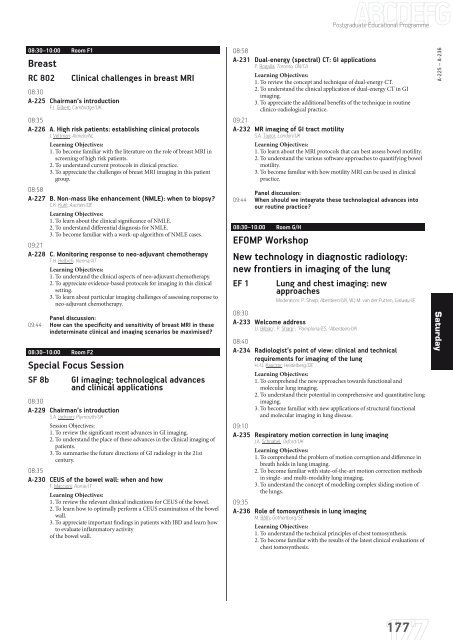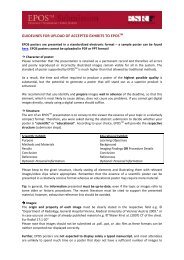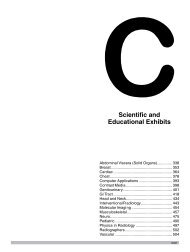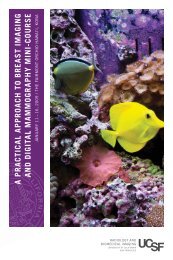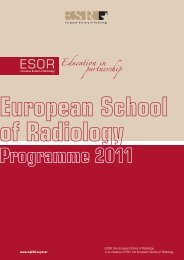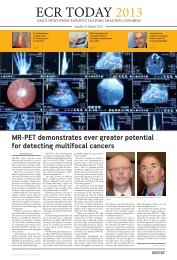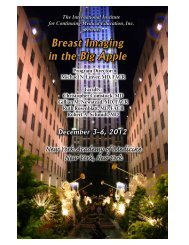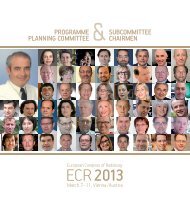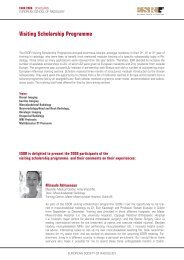ECR 2013 â Final Programme - myESR.org
ECR 2013 â Final Programme - myESR.org
ECR 2013 â Final Programme - myESR.org
- No tags were found...
Create successful ePaper yourself
Turn your PDF publications into a flip-book with our unique Google optimized e-Paper software.
Postgraduate Educational <strong>Programme</strong>08:30–10:00 Room F1BreastRC 802Clinical challenges in breast MRI08:30A-225 Chairman‘s introductionF.J. Gilbert; Cambridge/UK08:35A-226 A. High risk patients: establishing clinical protocolsJ. Veltman; Almelo/NLLearning Objectives:1. To become familiar with the literature on the role of breast MRI inscreening of high risk patients.2. To understand current protocols in clinical practice.3. To appreciate the challenges of breast MRI imaging in this patientgroup.08:58A-227 B. Non-mass like enhancement (NMLE): when to biopsy?C.K. Kuhl; Aachen/DELearning Objectives:1. To learn about the clinical significance of NMLE.2. To understand differential diagnosis for NMLE.3. To become familiar with a work-up algorithm of NMLE cases.09:21A-228 C. Monitoring response to neo-adjuvant chemotherapyT.H. Helbich; Vienna/ATLearning Objectives:1. To understand the clinical aspects of neo-adjuvant chemotherapy.2. To appreciate evidence-based protocols for imaging in this clinicalsetting.3. To learn about particular imaging challenges of assessing response toneo-adjuvant chemotherapy.Panel discussion:09:44 How can the specificity and sensitivity of breast MRI in theseindeterminate clinical and imaging scenarios be maximised?08:30–10:00 Room F2Special Focus SessionSF 8b GI imaging: technological advancesand clinical applications08:30A-229 Chairman‘s introductionS.A. Jackson; Plymouth/UKSession Objectives:1. To review the significant recent advances in GI imaging.2. To understand the place of these advances in the clinical imaging ofpatients.3. To summarise the future directions of GI radiology in the 21stcentury.08:35A-230 CEUS of the bowel wall: when and howF. Maccioni; Rome/ITLearning Objectives:1. To review the relevant clinical indications for CEUS of the bowel.2. To learn how to optimally perform a CEUS examination of the bowelwall.3. To appreciate important findings in patients with IBD and learn howto evaluate inflammatory activityof the bowel wall.08:58A-231 Dual-energy (spectral) CT: GI applicationsP. Rogalla; Toronto, ON/CALearning Objectives:1. To review the concept and technique of dual-energy CT.2. To understand the clinical application of dual-energy CT in GIimaging.3. To appreciate the additional benefits of the technique in routineclinico-radiological practice.09:21A-232 MR imaging of GI tract motilityS.A. Taylor; London/UKLearning Objectives:1. To learn about the MRI protocols that can best assess bowel motility.2. To understand the various software approaches to quantifying bowelmotility.3. To become familiar with how motility MRI can be used in clinicalpractice.Panel discussion:09:44 When should we integrate these technological advances intoour routine practice?08:30–10:00 Room G/HEFOMP WorkshopNew technology in diagnostic radiology:new frontiers in imaging of the lungEF 1 Lung and chest imaging: newapproachesModerators: P. Sharp; Aberdeen/UK, W.J.M. van der Putten; Galway/IE08:30A-233 Welcome addressJ.I. Bilbao 1 , P. Sharp 2 ; 1 Pamplona/ES, 2 Aberdeen/UK08:40A-234 Radiologist’s point of view: clinical and technicalrequirements for imaging of the lungH.-U. Kauczor; Heidelberg/DELearning Objectives:1. To comprehend the new approaches towards functional andmolecular lung imaging.2. To understand their potential in comprehensive and quantitative lungimaging.3. To become familiar with new applications of structural functionaland molecular imaging in lung disease.09:10A-235 Respiratory motion correction in lung imagingJ.A. Schnabel; Oxford/UKLearning Objectives:1. To comprehend the problem of motion corruption and difference inbreath holds in lung imaging.2. To become familiar with state-of-the-art motion correction methodsin single- and multi-modality lung imaging.3. To understand the concept of modelling complex sliding motion ofthe lungs.09:35A-236 Role of tomosynthesis in lung imagingM. Båth; Gothenburg/SELearning Objectives:1. To understand the technical principles of chest tomosynthesis.2. To become familiar with the results of the latest clinical evaluations ofchest tomosynthesis.A-225 – A-236Saturday177


